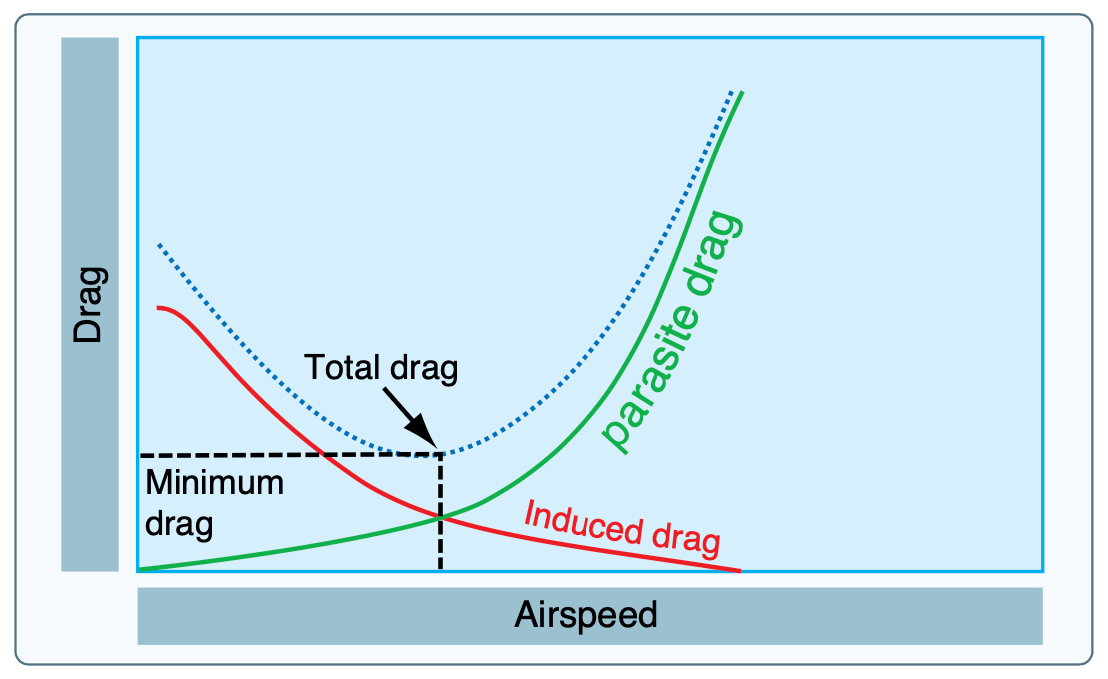Slow Flight and Stalls
Slow Flight
Objective
Maintain coordinated airplane control at speeds slower than cruise speed.
Concepts

- Drag is minimum at best glide speed (best L/D).
- To go faster than best L/D, we need more thrust to overcome parasite drag.
- To go slower than best L/D, we need more thrust to overcome induced drag.
- The goal of slow flight is to operate slower than best L/D, where additional power is required.
Operations
- Start with a reduction in power.
- Put in flaps one notch at a time, anticipating the nose-up pitching movement when flaps are lowered.
- Start pushing in power as we get slower.
- Elevator controls pitch, power controls airspeed.
- Controls become spongy.
- Left-turning tendencies will increase:
- Higher torque from higher power.
- Higher slipstream from higher power.
- Higher P-factor from higher power and AoA.
- Turns should remain very shallow since most of our lift is being converted to drag.
- Good to introduce after the 4 fundamental maneuvers.
Common Errors
- Failure to clear the area.
- Inadequate elevator back-pressure.
- Fixation on the airspeed indicator.
- Inadequate compensation for left-turning tendencies.
- Failure to anticipate changes in lift with changes in flaps.
- Inability to divide attention between inside and outside the airplane.
Power-Off Stalls
Objective
Develop recognition of an impending stall in a landing configuration and apply proper recovery technique, avoiding a secondary stall.
Operations
- Slow the airplane as you would in slow flight.
- Allow the airplane to descend as in a landing.
- Slowly pitch up until a stall warning, then a stall.
- Symptoms of a stall
- Nose-high attitude
- Low airspeed
- Sloppy or mushy controls
- Stall warning horn, light
- Buffeting
- Nose pitching down
- Recovery
- Move elevator forward just enough to eliminate the stall symptoms
- Add full power, which will add left-turning tendency
- Use enough rudder to stop wings from dropping (but not bringing the wing back up)
- Bring wings level
- Secondary stall
- Being too abrupt when recovering pitch with the elevator can cause a secondary stall
- Adding flaps can increase the likelihood of a wing drop
Common Errors
- Failure to clear the area
- Inability to recognize impending stall condition
- Premature recovery
- Over-reliance on airspeed indicator
- Inadequate rudder control
- Inadvertent secondary stall
- Excessive forward pressure during recovery
- Excessive airspeed build-up during recovery
Power-On Stall
Objective
To develop recognition of an impending stall or stalled condition in the takeoff configuration, and initiated recovery.
Operation
- Reduce throttle, keep the airplane level, slow to rotation speed
- At rotation speed apply full power and raise the nose to about 20 degrees
- Stalls may occur more quickly
- Recovery
- Small reduction in elevator back pressure enough to eliminate the stall warnings
- Use rudder to stop any wing from dropping
- Raise any dropped wing with aileron during the climb
Spins
A spin is caused by a stall aggravated by yaw.